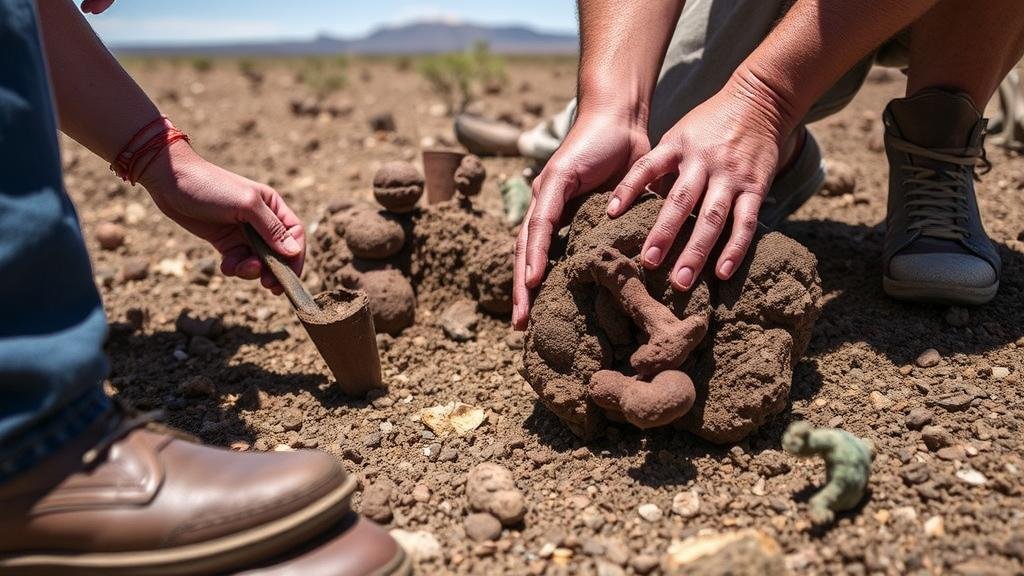Unearthing hematite concretions, known as “iron roses,” in the volcanic plains near Lordsburg.
Unearthing Hematite Concretions: A Guide for Rockhounds Near Lordsburg
The volcanic plains surrounding Lordsburg, New Mexico, are a treasure trove for rockhounds and mineral collectors, particularly for those seeking hematite concretions, commonly referred to as iron roses. These striking formations are not only visually captivating but also represent a unique geological process that can be understood through their physical properties and origins. This article will provide an in-depth exploration of hematite concretions, their location, characteristics, and practical tips for budding collectors.
Understanding Hematite Concretions
Hematite, a mineral composed of iron oxide (Fe2O3), is renowned for its metallic sheen and reddish-brown color. Concretions are hard, compact masses formed from mineral matter, and hematite concretions are specific aggregates where iron oxide predominates. develop in sedimentary rock contexts, where precipitation of minerals occurs due to biochemical or chemical processes.
The physical appearance of these “iron roses” is what sets them apart. They often exhibit a radiating, petal-like structure, reminiscent of a blooming flower. These concretions can measure anywhere from a few centimeters to over a meter in diameter. mineral’s crystalline structure contributes to their unique shapes, allowing collectors to appreciate both their aesthetic and geological significance.
Geological Context of the Volcanic Plains
The volcanic plains near Lordsburg are rich in diverse geological formations, primarily consisting of basalt and other volcanic rocks. The specific conditions that favor the formation of hematite concretions here are linked to the areas volcanic activity millions of years ago. The regions volcanic rocks provide an environment where mineral precipitation can occur, influenced by groundwater movement and geothermal heat.
According to a study published in the New Mexico Geology journal, organic matter decomposition and the circulation of iron-rich groundwater contribute significantly to the formation of these concretions. temperature and acidity levels in these environments play crucial roles, creating a conducive setting for hematite to crystallize and flourish.
Tips for Collecting Hematite Concretions
For rockhounds eager to discover and collect these unique formations, here are some essential tips:
- Research Local Regulations: Before heading out, ensure you are familiar with local laws regarding rock collecting. Some areas may have restrictions to protect geological heritage.
- Use Proper Tools: Equip yourself with basic collecting tools such as a rock hammer, chisel, safety goggles, and a sturdy backpack. These tools can help you safely extract specimens without damaging them.
- Know the Best Locations: Specific sites within the volcanic plains near Lordsburg are known for their abundance of hematite concretions. Join local rockhounding groups or forums to learn about the most productive places.
- Inspect Slope Areas: Concretions are often found in loose soil or sediments near slopes or dry riverbeds. Look for outcrops where erosion may have exposed these formations.
- Record Your Findings: Keep a field journal of your collecting experiences. Documenting locations, sizes, and characteristics of your finds can enhance your understanding and appreciation of your collection.
Real-World Applications and Scientific Significance
Hematite concretions possess more than just aesthetic value; they also have practical applications and significance in various scientific domains. r unique formation processes offer insights into past geological and environmental conditions, acting as indicators of iron availability in ancient ecosystems. Also, hematite is extensively used in various industries, notably in the production of iron and steel.
Specimens of hematite are also prized in jewelry making and as decorative pieces. The vibrant colors and unique formations make them desirable among collectors and artists alike. Plus, studying these concretions can contribute to educational discussions around mineralogy, geology, and environmental science.
Actionable Takeaways
Unearthing hematite concretions in the volcanic plains near Lordsburg presents an exhilarating opportunity for rockhounds and mineral collectors. By understanding the geological context, applying sound collecting practices, and appreciating their broader significance, enthusiasts can genuinely enhance their collecting experience. Whether you’re a seasoned collector or a curious beginner, these remarkable iron roses await discovery, offering both beauty and knowledge in the world of geology.



